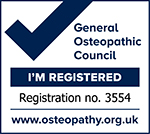
Osteopathic Treatment for Knee Pain in the UK: A Holistic Approach
Introduction
Knee pain is a common ailment that can significantly impact an individual’s quality of life. Whether it’s caused by an injury, arthritis, or other underlying issues, seeking effective treatment is crucial for pain relief and improved mobility. In the UK, osteopathic treatment has gained popularity as a holistic approach to managing knee pain.
Understanding Osteopathic Treatment
Osteopathy is a branch of complementary and alternative medicine that focuses on the musculoskeletal system’s health. Osteopaths aim to diagnose, treat, and prevent various musculoskeletal conditions, including knee pain. Osteopathic treatment takes a holistic approach, emphasizing the interconnectedness of the body’s systems and the body’s innate ability to heal itself. Osteopaths believe that if the musculoskeletal system is functioning optimally, it can aid in the resolution of pain and discomfort.
Osteopathic Treatment for Knee Pain
When it comes to knee pain, osteopathic treatment takes a comprehensive approach that involves several steps:
-
Assessment: Osteopaths start by thoroughly assessing the patient’s condition. They take into account the patient’s medical history, lifestyle, and any previous injuries. The physical examination will initially focus on the knee itself to pinpoint what might be causing the knee pain. This could be an injury or strain to structures such as the ligaments or meniscus, pain under the kneecap (patellofemoral syndrome), bursitis, ITB syndrome or many other issues. Additionally the whole body is looked at to see what kind of biomechanical factors may be contributing to pain or dysfunction within the knee.
-
Treatment Plan: Based on their findings, osteopaths develop a personalized treatment plan. This plan may include a combination of manual techniques, exercises, and lifestyle recommendations aimed at addressing the root cause of the knee pain.Manual Techniques: Osteopathic treatment often involves hands-on manipulation of the knee joint and surrounding tissues. This helps improve blood flow, reduce inflammation, and restore proper function to the affected area.
-
Exercise Prescription: Osteopaths will also recommend specific exercises to strengthen the muscles supporting the knee joint and improve overall joint stability. These exercises can play a vital role in long-term pain management and prevention.
-
Lifestyle Advice: Osteopaths may provide guidance on lifestyle changes to support the healing process and prevent future knee issues.
Benefits of Osteopathic Treatment for Knee Pain
Osteopathic treatment offers several advantages for individuals suffering from knee pain:
-
Non-Invasive: Osteopathic treatment is non-invasive and drug-free, making it a safe option for those seeking alternatives to surgery or medication.
-
Holistic Approach: Osteopathy considers the whole body, not just the knee joint, addressing the root cause of pain rather than just its symptoms.
-
Personalized Care: Osteopaths tailor their treatment plans to each patient’s unique needs, ensuring individualized care.Pain Relief: Osteopathic treatment can provide effective pain relief, helping patients regain their mobility and quality of life.
-
Preventive Measures: Osteopaths emphasize prevention, teaching patients how to maintain optimal musculoskeletal health to prevent future knee problems.



